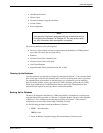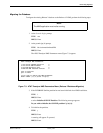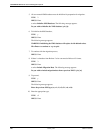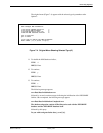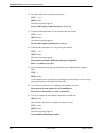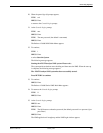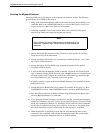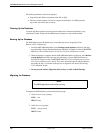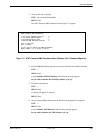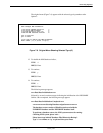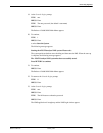
COMSPHERE 6800 Series Network Management System
7-24 January 1997 6800-A2-GN22-30
Checking the Migrated Database
Following NMS start-up, the integrity of the migrated data should be verified. The following
procedures may be executed for that purpose.
1. Bring up the System Management window and execute the Create Network Map (crnm)
command. Refer to the COMSPHERE 6800 Series Network Management System Core
Command Reference Manual for details on all commands.
2. Following completion of the Create Network Map (crnm) command, bring up the
network map window and inspect the network map visually.
NOTE
Circuit names and device addresses are not displayed on the
Release 4.2 network map. Device names and site names are
displayed.
3. Execute the Display Device Profile (dsdp) command to verify profiles for 3 devices.
Verify the accuracy of the information.
4. Execute the Display Site Profile (dssp) command to examine profiles for 3 sites. Verify
the accuracy of the information.
5. Execute the Display Facility Profile (dsfp) command to examine facility profiles
associated with three devices.
6. If ACCULINK Network Manager (ANM) is installed, execute the List Facility Profile
(lsfp) command, selecting T1 for the facility type and m2/* for Device(s) if multiplexers
are attached to the NMS. Compare the screen results with a hard copy output from the
List Node Connectivity (lsnc) command on the source system.
7. If ANM is installed, execute the Hardware Module Summary (hms) command on three
multiplexer devices.
8. Execute the Device Health Status (dhs) command on available device types, e.g., three
DATAPHONE II devices, three COMSPHERE devices, and three ANALYSIS devices.
9. Run Alert History reports to list Historical Alerts using the Detailed Alert Report (dar)
and Alert Report Summary (ars) commands.
10. If user group permissions have been customized, use the SQL Customization Package to
examine the command_view table. Correct any incomplete migration of data and account
for the new capabilities of Release 4.2, specifically, that all Network Control commands
can now have customized user group levels. Likewise, if alert text or alert group names
have been customized, redo the customization after the migration is completed.
11. When the migration is completed, execute the Edit Alert Monitoring State (edams)
command to turn on polling. NMS will then automatically acquire the current feature
packages/versions for the multiplexer network, if ANM is installed.




